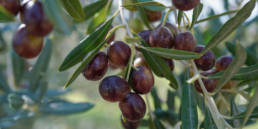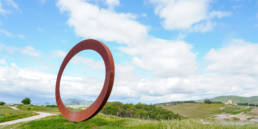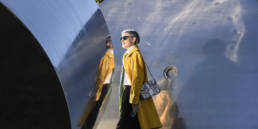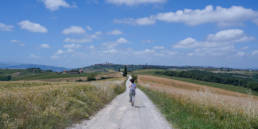Certaldo is a town in Tuscany best known for two things: they grow wonderfully sweet purple onions (cipolle di Certaldo); and, of no lesser importance, Certaldo is where Giovanni Boccaccio spent the final thirteen years of his life. The suggestion that Giovanni was born in Certaldo in 1313 has been mostly disproved (he was probably born in Florence), but Certaldo is the native city of his father, Boccaccio di Chellino, and the author was indeed familiar with the town early in life. It gets a flattering mention as the setting for the tenth story on the sixth day of The Decameron: “Certaldo, as you may possibly have heard, is a fortified town situated in the Val d’Elsa, in Florentine territory, and although it is small, the people living there were at one time prosperous and well-to-do.”

On a hot late July day I visited Certaldo for the first time upon the invitation of Judy Witts, best known to the blogosphere as Divina Cucina, where she delights us with her mouthwatering culinary photography and adventures. I’d never been to Certaldo, and found it easy to reach by train from Florence (50 minutes, cost about 4 euros). Certaldo is divided into a lower town, where the train station and most stores and services are for residents, and an upper historical town accessible by an inexpensive funnicular that runs every 15 minutes.

The town has three museums accessed by one ticket (6 euros for adults), which include a house museum dedicated to Boccaccio (Casa di Boccaccio), a museum of sacred art, and the priors’ palace. All are conveniently located on the main street, which is not surprisingly named Via Boccaccio. Also on this street is the church of SS. Jacopo e Filippo where you can see Boccaccio’s tomb marker in the floor.
The palazzo pretorio, or prior’s palace, was the home of the Alberti lords and later of the governing body of Certaldo. It’s located at the far end of via Boccaccio that you can easily see from its beginning when you come up the funnicular. This is a really interesting space with rooms off a central courtyard. As the prior was responsible for the detainment and punishment of criminals, some of the spaces were used as jail cells. One room in particular shows evidence of this use by the scratched in lines representing days spent in confinement, and by the innovative use of charcoal to write rather poetic lines on the ceiling dating from 1555. The rooms of this palace are often used to display modern and contemporary art which makes a nice contrast and adds a layer of things to look at.

The pinacoteca or painting gallery houses a nice little collection that is certainly worth stopping in to see. Of particular interest is a sculpted wooden Petrognano Crucifix, a triumphans type with Christ live on the cross. The date and origin of this work is subject of scholarly debate (but it is from some time in 13th-century Italy).
Of peculiar note, there is also a separate Museo del Choido – a museum of antique nails, and other bits and bobs of iron and metal tools and building supplies. This costs a euro to get in and should be fun for kids and bigger male kids (ie. men).

I was excited to be going for lunch in a town known historically (all the way back to the 12th century for sure) for very fresh onions. The medieval town’s symbol was a shield with a glorified purple onion on a white background. This symbol can still be seen in a fresco on the wall of the Palazzo Pretorio. The town motto is a metaphoric encomium to the onion that can be loosely translated as “by nature I am both strong and sweet, and I please those at work and those at rest”. Amusingly, the lowly onion was removed from the crest in 1633, but reinstated 1867. For lunch at Trattoria La Casalinga (via Roma 44, tel. +39 0571/668198), Judy and I had panzanella (bread salad) with fresh raw statina onions that proved to be perfectly digestible. Judy’s husband Andrea ordered the local specialty, pasta with onion pesto, which I hope to recreate at home.
Certaldo maintains the character of a small medieval town that has not been beseiged by tourists. You can see the towers of San Gimignano on its hill in the nearby countryside, but there are no kitch souvenir stores or tourist trap restaurants here. For a list of where to eat in Certaldo, see this list on Judy’s website.
Further reading
- if you like Certaldo, you might also like Pienza, which is known for pecorino cheese.
- Read Boccaccio’s classic novella – 100 funny short stories written in 1348 and considered very racy. Priests being duped, men being cuckolded, and numerous funny jokes in Boccaccio: The Decameron
.

Sign up to receive future blog posts by email
Alexandra Korey
Alexandra Korey aka @arttrav on social media, is a Florence-based writer and digital consultant. Her blog, ArtTrav has been online since 2004.
Related Posts
November 17, 2021
My favourite suppliers of Tuscan olive oil
May 20, 2021
Volterra: Art, Wine and Minerals
January 17, 2021




